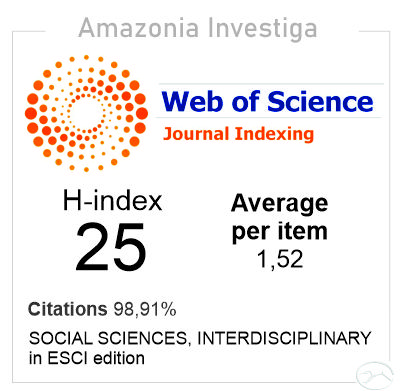Qualitative and Quantitative Evaluation Techniques of New Infill Designs in Historic Context
DOI :
https://doi.org/10.34069/AI/2020.35.11.2Mots-clés :
Historic Context, interpretation, new infill, qualitative evaluation, quantitative evaluation.Résumé
With the continuing advancement in material technology and construction techniques, architects face a greater set of options and challenges when it comes to designing in historic settings. In the meantime after the ICOMOS agreement, every country adapted the policy according to their own culture and settings, therefore every architect in their respective country started interpreting the charters, and the design review processes in their own way. Working on the new addition to historic context gave rise to familiar characteristics in design, especially in the infill designs, which is “Replication and Contrast”, which in turn sparked the question, how to evaluate whether a building is properly fitting in its context with whatever approach employed. This paper aims to answer this question by conducting a literature review covering First, the qualitative evaluation approach which compromises of surveys and pre-visualization in order to identify the main visual properties that improve the contextual compatibility of the new designs in the historical context, and quantitative techniques focused more on the mathematical scientific cognitive results of all aspects of the architectural elements within historic settings. A comparison has been made on each result achieved and an assessment of their reliance or authenticity has been tested in order to find and bridge the gap between tangible and intangible values when judging “fit” in a historic setting. The results showed that the qualitative evaluation if followed properly it could be very promising, but it always leaves room for skepticism as the result is expected to change based on the size and the characteristics of the participants. The quantitative evaluation provided a more tangible evidence of the contextual fit in terms of architectural elements like size, proportion, and scale. Finally, a suggestion was made in order to provide a better, and a more comprehensive technique merging both methods together and trying to incorporate more of three-dimensional aspects of the building instead of the two dimensionality of the current assessment techniques.
Téléchargements
Références
Al-Askary A. H. A. A., Al-kaissi A. O. H. (2016). Visual Integrations of Historic Cities Centers Al Rashed Street. Center of Urban and Regional Planning. University of Baghdad. 12(1), pp 81-107
Bland, J. M., & Altman, D. G. (1996). Statistics notes: measurement error proportional to the mean. Bmj, 313(7049), pp. 106.
Booth, Ph. (1989). The rule, discretion, and local responsibility: Development control case studies in the urban community of Lyon (Doctoral Dissertation), University of Sheffield.
Brolin, B. C. (1980). Architecture in Context: Fitting New Buildings with Old. New York: Van Nostrand ReinholdCompany.
Bulimbaši?, S. (2008). In the service of heritage, Conversation. Kvartal: Crónica de la historia del arte croata, vol. V (4), pp. 22-32
Charter, A. (1931). The Athens Charter for the restoration of historic monuments. In Ist International Congress of Architects and Technicians of Historic Monuments, Athens, October.
Council of Europe (1975). The Declaration of Amsterdam, Congress on the European Architectural Heritage. Amsterdam.
Davies, M, (2003). Design in the Historic Environment. Building and Environment, Recovered from http://www.buildingconservation.com/articles/design/design.htm
Day, L. L. (1992). Placemaking by Design. Environment and Behavior, 24(3), pp 326–346. doi:10.1177/0013916592243003
Demiri K. (2013). New Architecture as Infill in Historical Context. Architectural and Urban Planning, 5, pg 44-50, doi: 10.7250/ aup 2015.
English Heritage (2007). Conservation principles policies and guidance for the sustainable management of the historic environment. English Heritage, 30-33.
Fechner, G. T. (1876). Vorschule der Asthetik. Leipzig. Germany: Breitopf & Hartel, Recovered from: https://archive.org/details/vorschulederaest12fechuoft/page/n229/mode/2up.
Gharehbaglou, M., Nejadebrahimi, A., Ardabilchi, I. (2019). Infill Architecture: An Interdisciplinary Approach to the Design of Historic Context Case Study: Mashruteh Complex in the Historic Bazaar of Tabriz, Iran. Revista científica de Bagh-e Nazar, 16(76), pp. 57-68.
Groat, L. (1983). Measuring the fit of new to old. Architecture, New York: Cambridge University Press. November, 58-61.
Groat, L. N., & Despres, C. (1991). The significance of architectural theory for environmental design research. In E. H. Zube & G. T. Moore (Ed.), Advances in environment, behavior, and design (Vol. 3, p. 3-53). New York: Plenum.
Horler, M. (1975). Modern architecture and Ancient monuments. Monumentum, 11,7-25.
Hu, Y., Heath, T., Tung, Y., & Zhang, Q. (2017). Using Quantitative Analysis to Assess the Appropriateness of Infill Buildings in Historic Settings. Jorunal of Architectural and Planing Research, 34(2).
ICOMOS 1972. Resolutions of the Symposium on the introduction of contemporary architecture into ancient groups of buildings, at the 3rd ICOMOS General Assembly, Budapest. [online 17.07.2018] Recovered from https://www.icomos.org/en/chartersand-texts/180-articles-en-francais/chartes-et-normes/383-resolutions-of-the-symposium-on-the-introduction-ofcontemporary-architecture-into-ancient-groups-of-buildings-at-the-3rd-icomos-general-assembly
ICOMOS, A. (2013). The Burra Charter: The Australia ICOMOS charter for places of cultural significance. Australia ICOMOS Incorporated.
ICOMOS, F. C. F. (1982). Economic and financial aspects of the conservation of monuments and historic city centres. Availabe: https://www.icomos.org/en/368-whp/cultural/3049-1982
ICOMOS, U. (2011). The Valetta Principles for the Safeguarding and Management of Historic Cities, Towns and Urban Areas. 7th ICOMOS General Assembly.
ICOMOS, V. C. (1964). International Charter for the Conservation and Restoration of Monuments and Sites-Developed at the 2nd International Congress of Architects and Technicians of Historic Monuments. Venice, Italy.
Lang, J. (1987). Creating architectural theory: The role of the behavioral sciences in environmental design. New York: Van Nostrand Reinhold.
Lang, J. (1988). Symbolic aesthetics in architecture: Toward a research agenda. In J. L. Nasar (Ed.), Environmental aesthetics: Theory, research, and applications, New York: Cambridge University Press, 11-26.
Loew, S. (1998). Modern architecture in historic cities: Policy, planning and building in contemporary France. London: Routledge. http://dx.doi.org/10.4324/9780203380222.
Mohanty, R. N., Chani, P. S. (2015). Infill Design in the Historic Precinct of Haridwar, Journal of Civil Engineering and Environmental Technology, 2(3), pp 265-270.
Mokhovikov, S., Alekseenko, L., Knyazeva, M., Murog, I., & Larina, O. (2019). Studies of cultural heritage sites of federal significance. Amazonia Investiga, 8(21), pp 296-306. https://amazoniainvestiga.info/index.php/amazonia/article/view/106
Nasar, J. L. (1989). Perception, cognition, and evaluation of urban places. In Public places and spaces (pp. 31-56). Springer, Boston: MA.
Nasar, J. L. (1997). New developments in aesthetics for urban design. In Toward the integration of theory, methods, research, and utilization (pp. 149-193). Springer, Boston: MA.
Navickiene, E. (2012). Infill Architecture: Chasing Changes of Attitudes in Conservation of Urban Heritage. In HERITAGE 2012 – proceedings of the 3rd international conference on Heritage and Sustainable Development, Lithuania, Vol. 2, p. 1325–1334.
Overby, O. R. (1980). Old and New Architecture: A History. Washington D.C: the preservation press, 12, 18-36, Recovered from: https://archive.org/stream/oldnewarchitectu0000unse?ref=ol#page/20
Punter, J. (1999). Design guidelines in American cities: A review of design policies and guidance in five west coast cities (Vol.2). Liverpool: Liverpool University Press.
Purcell, A. T. (1984). Multivariate models and the attributes of the experience of the built environment. Environment and Planning B: Planning and Design, 11(2), 193-212.
Purcell, A. T. (1986). Environmental perception and affect: A schema discrepancy model. Environment and Behavior, 18(1), 3-30.
Rahman, O. M. A., (1992). Visual quality and response assessment: an experimental technique. Environment and Planning B: Planning and Design, 19(6), pp. 689–708. doi:10.1068/b190689.
Reed, S. (1978). Schemes and theories of pattern recognition. In Cartrette, E. C., x(Ed.), Handbook of Perception (p. 139-162). Vol. 9. New York: Academic Press.
Rosch, E., and Mervis, C. B. (1975). Family resemblances: Studies in the internal structure of categories. Cognitive Psychology, 7(4), 573-605.
Skerry, A. D. (2012). Interpreting the standards: design professional and historicized design (Master’s Thesis). Roger Williams University, Bristol.
Soosani, L. (2013). Questioning the compatibility of the infill architecture in historic environment, case study: walled city of Nicosia (Doctoral dissertation) Institute of graduate studies and research, urban design, Eastern Mediterranean University, Famagusta.
Sotoudeh, H., and Abdullah, W. M. Z. W. (2012). Affected variables on successful infill design in urban historic context. Art and Design Studies, 3(9), pp. 7-12.
Sotoudeh, H., and Abdullah, W. M. Z. W. (2013). Contextual preferences of experts and residents: issue of replication and differentiation for new infill design in urban historical context. World Applied Sciences Journal 21(9), pp. 1276–1282.
Stamps, A. E. (1997) A paradigm for distinguishing significant from non-significant visual impacts: theory, implementation, case histories. Environmental Impact Assessment Review, 17(4), 249-293.
Ukabi, E. B. (2016). Harnessing the Tension from Context-duality in Historic Urban Environment. Journal of Sustainable Development, 9(1), p 77.
Vozbinaite, G. K. (2015). New Forms in Historic Urban Environment: Regeneration of Vilnius Old Town (Master’s Dissertation), Department of Architecture, University of Strathclyde, Glasgow. Recovered from: https://issuu.com/guoste/docs/new_forms_in_historic_urban_environ.
Wohlwill, J. F. (1976). Environmental aesthetics: The environment as a source of affect. In I. Altman and J. F. Wohlwill (Ed.), Human behavior and the environment: Advances in theory and research (Vol. 1, pp. 37-86). New York: Plenum.
World Heritage committee (2005). Decisions of the 29th session of the World Heritage Committee. For the convention concerning the protection of the world cultural and natural heritage. Symposium led by UNESCO, Durban.

































































.gif)






